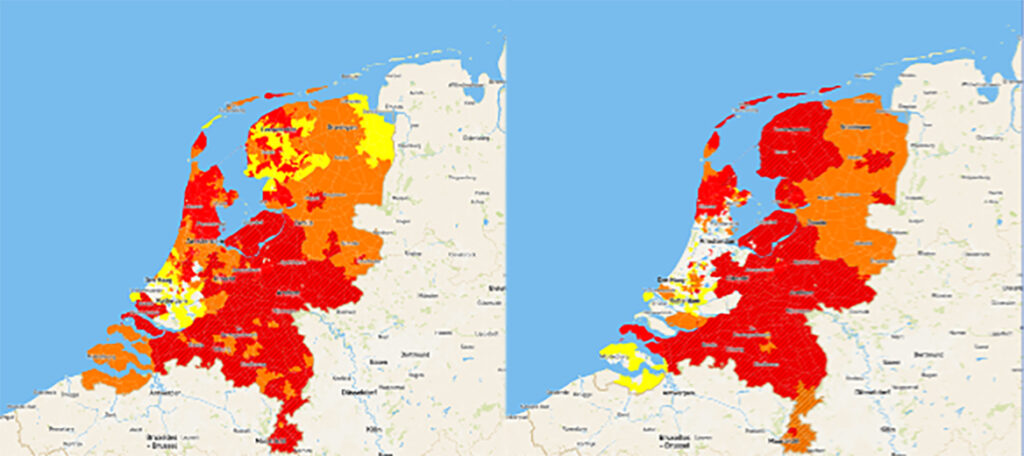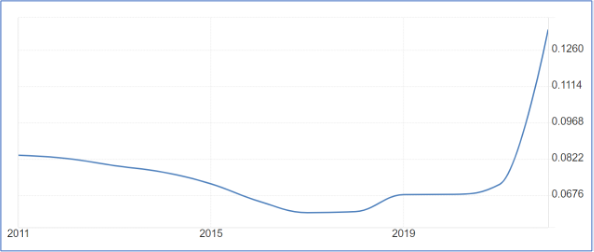The surge in demand is caused by structural economic factors, like a growing economy, digitalization of society and the strive for sustainability, accelerated by recent geopolitical unrest and subsequent fuel price volatility (3). As such, many businesses are now facing fundamental barriers for expansion, as well as uncertainty in their existing supply chains.
“While approximately 6,000 companies are waiting on a grid connection for energy use, 8,000 companies are waiting for a grid connection for energy supply.”
How will this impact companies?
Companies could wait up to 8 months to obtain a permit for a new grid connection in Germany (2). In The Netherlands, current waiting time in logistics “hot-spots” like Schiphol, Eindhoven or Tilburg-Waalwijk has passed the 5-year-mark (4). Even worse so, heavy grid connections, as required by energy-intensive production companies, are no longer approved in certain areas where the grid is structurally congested (5) – the red areas in Figure 1a. There is even a waiting list for providing energy back to the grid (red areas in Figure 1b), for instance via solar panels. While approximately 6,000 companies are waiting on a grid connection for energy usage in The Netherlands, 8,000 companies are held off for energy supply (6). In the UK, the waiting list for large renewable projects to obtain a supply-grid connection reaches up to 13 years (7). For these companies, investments in renewable energy sources are either limited or, if already executed, not giving the expected financial yield.

Figure 1. A visual representation of grid congestion by Netbeheer Nederland with a) on the left side electricity use capacity (demand) and b) on the right side electricity infeed capacity (supply). (8)
But there are other potential costs resulting from grid congestion that companies need to consider. Costs that may not affect your company directly, but will definitely impact you via upstream or downstream partners in your supply chain. For example, the cost of electricity is rising in recent years due to a structural supply shortage (see Figure 2). In addition, the risk of energy blackouts becomes more imminent with the overloading of grid infrastructure (5). This could impose indirect costs on companies in a number of ways: spoiled inventory due to temperature control malfunctions, delivery delays due to outage of production or automatic storage systems or inventory theft when security systems malfunction.

Figure 2. The development of electricity prices in the Netherlands for non-household, medium-size consumers between 2011 – 2022. (9)
“The key in these optimizations is to accurately represent and quantify all factors that are important in your business environment. Costs, objectives, and risks alike. Clearly, this is not an easy exercise.”
What can companies do in the short- to medium-term?
Reduce energy usage / cost
Companies that want to react promptly to the increased risks of grid congestion should start with the obvious: reduce electricity consumption. The implementation could range from straight-forward measures like insulating warehouses to more complicated measures like process- and planning optimization. Companies could, for example, optimize for maximum efficiency of manufacturing processes so they use up less energy or optimize the charging schedule for electric delivery trucks. The key in these optimizations is to accurately represent and quantify all factors that are important in your business environment. Costs, objectives, and risks alike. Clearly, this is not an easy exercise. Consider a company that wants to maintain their current service level while reducing energy costs. It may find a positive business case for postponing order picking until evening hours when order picking solutions are mostly automated, while the same measure may not be beneficial if order picking is largely manual, as labor surcharges apply after standard working hours.
Review contractual obligations and risks
Additionally, third-party logistics providers (3PLs) or companies working with a logistics partner should make an overall risk estimation and attempt to renegotiate unbalanced contracts to minimize negative (financial) consequences from power grid congestion. Some contracts contain a performance clause in which continued underperformance on agreed-upon KPIs presents the customer with the option to dissolve the contract without further cause. In this case, power outage should be mentioned as an exception (or force majeure). Furthermore, with the low margins in the logistics industry, logistics providers should make sure to contractually cover risk from volatility in electricity prices.
“Grid congestion poses a strategic opportunity if you manage to make your supply chain more resilient than those of competitors.”
What can companies do in the long-term?
For the long-term, it is important to realize that grid congestion is changing the business environment permanently and that companies have no impact on the development of the grid itself. What companies can do, is view the new business environment as an opportunity. Competitors are dealing with the same problem, so how you build resilience into your supply chain can form a competitive advantage for years to come. There are several directions for strategic investment.
Invest in alternative energy sources
Companies may choose to lower their dependency on electricity as a power source. Although no power source is without disadvantages, a well-balanced mix of energy sources may be the best mitigation strategy against volatility. This is especially relevant for logistical operations where power outages are costly, such as (semi-)automated warehouses. Affected companies could think about investing in bio-fuel or hydrogen-powered machinery or vehicles.
Build a virtual power grid
Companies with sufficient funds can combine renewable sources with energy storage systems, such as batteries, to bypass restrictions on the local power grid – a so-called “virtual power grid”. Sortiva, a waste management company in Alkmaar, invested in two wind turbines, its own solar park and a battery storage system as local grid restrictions were increasingly impacting operational continuance (10). Although relying on fossil-fuel based solutions is not environmentally desirable, it could be a solution to bridge small remaining gaps between volatile yields from renewable energy sources and your remaining energy requirements, while mitigating power outage risk. Somerset has opted for this solution for their DC in Hoofddorp and is only dependent on gas for roughly 10% of their energy demands (1).
Collaborate locally
Alternatively, companies with less investment possibilities may collaborate with each other to create a shared virtual power grid. In Veghel, a logistics hub for European distribution, local companies are doing exactly that (11). According to one of the local companies, they can now install the required loading infrastructure to support a fully electrified truck fleet; something that was not possible on the main power grid. Providing another example of successful local collaboration, 29 companies in the harbor of Amsterdam have just formed an energy hub –they can coordinate energy supply and demand amongst themselves via a collaborative group contract with the network operator and thereby improve the utilization of the main power grid (12).
Re-optimize your network design
The design of your logistics network was likely optimized for factors such as real estate expense, proximity to suppliers/customers, and availability of warehouse space. Though there is a good chance that grid congestion has changed your optimal warehouse location. Perhaps the optimal warehouse is located further away from your biggest customers, when the additional distribution costs are offset by substantial revenues from renewable energy supply, or your production costs are lowered when you move to an area with more stable energy supply. Another factor to consider is the action radius of electric delivery trucks. This becomes especially relevant from January 2025 onwards, when stricter regulations on emission zones in Dutch cities come into effect (13), pushing companies to invest (more) in electric vehicles. Due to changed circumstances, it can be worthwhile to investigate if your logistics network is still optimally configured.
Overall, it is imperative that companies review the position of their supply chain with regard to the risks and costs associated with energy grid congestion. Today’s business environment is different than before, and the changes are here to stay. This can be a strategic opportunity if you manage to make your supply chain more resilient than those of competitors. The final aim should be to minimize risk to your operations and to invest in a stable future energy supply.
Can you use some help in understanding the current state of your supply chain? Would you like to ensure that your strategic decisions are the rights ones? 4SupplyChain Consulting offers the Fit4Growth Diagnosis, which will provide you with the required insights to make these decisions with confidence. We also offer implementation support in the form of Project or Interim Management. Please contact us for more information.
Sources
- https://www.logistiek.nl/179600/somerset-realiseert-dc-in-hoofddorp-dat-geen-stroom-van-het-net-gebruikt
- https://www.merkur.de/wirtschaft/netzagenturchef-warnt-vor-stromnetz-ueberlastung-durch-elektroautos-und-waermepumpen-92027883.html
- https://www.rtlnieuws.nl/economie/artikel/5370388/alliander-stroom-net-congestie-zonnestroom-consument
- https://www.logistiek.nl/185106/overvol-stroomnet-bouw-nieuw-distributiecentra-in-gedrang
- https://www.abnamro.com/research/en/our-research/electricity-on-the-road-to-net-zero-challenges-and-solutions
- https://www.kenter.nu/nieuws/netcongestie-inzicht-in-de-wachtlijsten/
- https://www.ft.com/content/bc200569-cb85-4842-a59a-f04d342805fc
- https://capaciteitskaart.netbeheernederland.nl/
- https://tradingeconomics.com/netherlands/electricity-prices-non-household-medium-size-consumers-eurostat-data.html
- https://www.smartgrid.com/post/bypassing-net-congestion-with-smart-energy-systems
- https://vijfsterrenlogistiek.nl/nieuws/stroomnet-zit-vol-daarom-leggen-deze-bedrijven-hun-eigen-netwerk-aan/
- https://fd.nl/bedrijfsleven/1506857/bedrijven-in-amsterdamse-haven-gaan-stroom-delen?utm_medium=social&utm_source=app&utm_campaign=earned&utm_content=20240208&utm_term=app-ios&gift=ZuimF
- https://www.tln.nl/nieuws/maatregelen-stroomnet-van-belang-voor-transport-en-logistieke-sector/

